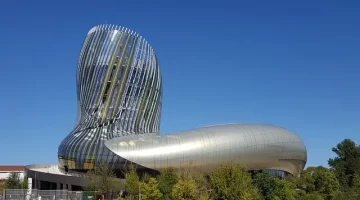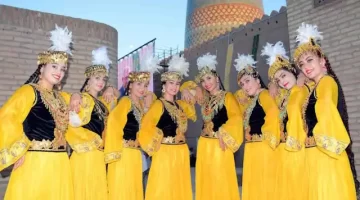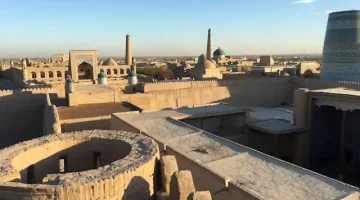Saint-Étienne Musée d’Art et d’Industrie
The Travel Pages visits the Museum of Art and Industry in Saint-Etienne, southwest of Lyon.

Saint-Étienne was once a much richer town than it is today, the wealth mainly produced through three very different industries: armaments, textiles and bicycles. These provide the three sections of this modern museum, housed in a mid-19th century building which was originally intended to house the sub-prefecture but never used for that purpose.
Main City for the Production of Ribbons
Saint-Étienne is still France’s main city for the production of ribbons, but today the fabrics have extended so that they are now also making seat belts, labels and medical fabrics as well as haute-couture fashion and even artificial veins. In the past Saint-Étienne made ribbons for priests’ vestments and even for the traditional clothing worn in other parts of France. A traditional Brittany costume, for example, would be adorned by ribbons made in Saint-Étienne.

Largest Collection of Ribbons in the World
Today the museum houses the largest collection of ribbons in the world, an astonishing three million samples, some going back over 200 years. There are also looms, including a full working model of a Jacquard loom. This type of loom, invented by Lyon’s Joseph Marie Jacquard (1752-1834), revolutionised weaving as it used a punch-hole system in cards. This system was later used by Charles Babbage (1791-1871) when he invented what were regarded as primitive versions of modern computers – but Jacquard had got there first. The museum also has a living silk-making exhibition with cocoons and caterpillars.

Weapons Collection
The weapons collection is the second-biggest in France after the Musée de l’Armée in Paris. It shows the development of firearms from early clumsy cannons to elaborately decorated muzzles and rifles that are truly works of art. There’s a double-barreled gun which belonged to Napoleon, and one of Louis XIV’s duck guns. Since the time of King François I, Saint-Étienne has made weapons for the Kings of France. The displays include horse armour, crossbows, huge two-handed swords and go right up to modern weapons such as a flash-ball gun, which is used by the police to fire balls and not bullets, and is only made in Saint-Étienne.

Saint-Etienne and Bicycles
The history of bicycles is more recent, but the collection here is just as comprehensive. The English may have invented the penny-farthing in the mid-19th century, but someone came to display it in Saint-Étienne and the idea was ‘borrowed’. The city began building its own bicycles and quickly became the biggest bicycle-manufacturing centre in France.
There are amusing examples of quirky early bicycles, and a 1936 tandem which is said to have been invented when the French introduced the concept of workers having paid vacations. There are bicycles where you change gear manually, or by back-pedalling, right through to modern machines where the rider changes the gears vocally. It’s a fascinating collection, and a fascinating museum.
2, place Louis Comte, 42026 Saint-Étienne
04 77 49 73 00
https://mai.saint-etienne.fr









